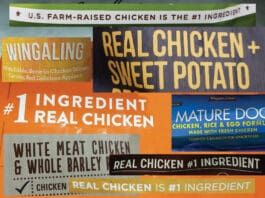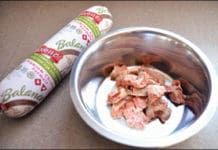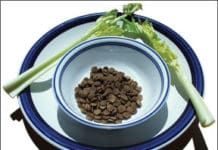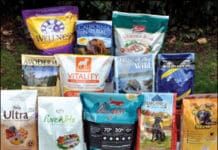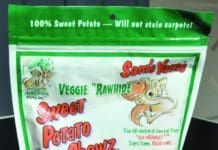Whole Dog Journal’s Commercial Frozen Raw Dog Food Review
The more I've learned about the meat used in pet food, the more I've come to admire commercially produced frozen raw diets for dogs. The meat and poultry used in most of these diets are far fresher and more wholesome - far more like what most of us would think of as "meat" - than most animal protein ingredients in dry (or even canned) pet foods. The products tend to produce terrific results in the dogs who consume them. Whether this is due to the ingredient quality or the fact that this type of diet is more biologically appropriate for canines than dry foods is anyone's guess. My guess is that both factors contribute to the success of the products.
Dog Breeders Who Only Feed Raw Dog Food Diets
You know you’ve been feeding raw for a long time when it no longer seems like a radical, ground-breaking, or – ubiquitous adjective for beginners – scary way to feed. When I started feeding raw – a dozen years and three generations of Rhodesian Ridgebacks ago – it was the Middle Ages of raw feeding. Ian Billinghurst’s Feed Your Dog a Bone was the hard-to-find illuminated manuscript (the lax editing could have stood some sprucing up by Benedictine monks), and everyone used the unfortunate acronym BARF, which stood for “bones and raw food” (or, later, the loftier-sounding “biologically appropriate raw food”). No commercial raw diets were available, and new converts dutifully ordered their Maverick sausage grinders over the Internet. The instruction booklet said the table-top grinder couldn’t be used on any bones harder than chicken necks or wings, but everyone ignored that.
AAHA to Create New Nutritional Guidelines
In January, the American Animal Hospital Association (AAHA) announced its plan to create a new set of nutritional guidelines for use by veterinarians and to publish these recommendations in June 2010.
Are Raw-Fed Dogs a Risk?
Delta Society is one of the largest and best-known organizations that registers and insures “pet therapy” volunteers and their companion animals. Pet/handler teams – known as Pet Partners – brighten lives in hospitals, nursing homes, group homes, schools, pre-kindergarten programs, libraries, jails, women’s shelters, homeless shelters, senior centers, adult day programs, and a host of other facilities. But on May 19, Delta Society triggered a firestorm of controversy, complete with conspiracy theories, angry denunciations, frustration, and confusion, when it announced that effective June 30, “any dog or cat from a household where raw protein food is fed is not eligible to be a Delta Society Pet Partner.” Delta’s Raw Protein Diet Policy raises serious questions about the safety of feeding raw food regardless of an animal’s pet-therapy status.
Using Your Dog’s Bowl As a Training Tool
You may think feeding your dog is a simple matter of dumping food in his bowl and plopping it down on the floor in front of him. You may be wrong. Mealtime is fraught with significance for your dog, and loaded with opportunities for you to influence his health and his behavior. Failure to take advantage of these could actually contribute to the development and/or escalation of problems that might otherwise be averted. A few deliberate decisions and choices on your part can go far in creating harmony in your home.
Problems With Artificial Preservatives in Dog Food
Recently we've heard from a number of dog owners who are concerned about the use of ethoxyquin to preserve fish meal that is used in dog foods. We've had one e-mail forwarded to us several times expressing worry over links between undeclared ethoxyquin in pet foods and canine cancer. We have long advised owners to pass over dog food that contains artificial preservatives such as butylated hydroxyanisole (BHA), butylated hydroxytoluene (BHT), tert-butyl hydroquinone (TBHQ), propyl gallate, and ethoxyquin, in favor of products made with natural preservatives, such as tocopherols (vitamin E), citric acid (vitamin C), and rosemary extract. Though synthetic preservatives were once as recently as 20 years ago the usual preservative found in all dry dog foods, today, they appear only on the labels of low-cost and lower-quality products.
HSUS Now Selling Vegetarian Dog Food
Earlier this year, the Humane Society of the United States (HSUS) entered the pet food market with its “Humane Choice” brand of organic vegetarian dog food. According to the product’s marketing materials, the impetus for the move was “to give pet guardians an option to feed their dogs a complete and balanced food that is also sustainably grown and helps us in our work to combat inhumane factory farm practices.”
Whole Dog Journal’s Dry Dog Food Review Update
Several of our eagle-eyed readers caught an error in dry dog food review in our February issue: “In the February 2010 issue, the picture of the approved dog foods includes Nutro Ultra but it is not listed in the article. Why the discrepancy?” “I see that Nutro Ultra is included in the photo on page 3; its caption says ‘these are just a few examples of premium quality foods.’ However, it’s not included on the ‘approved foods’ list. Can you clarify?” “I noticed that the Nutro Ultra Holistic food is in your picture, but I couldn’t find it in the actual list of approved foods. Is it one of the approved foods?”
Whole Dog Journal’s 2010 Dry Dog Food Review
Here is Whole Dog Journal's Approved Dry Dog Foods List for 2010. All these products meet our selection criteria - including our newest criterion, that the company discloses the name and location of its manufacturers. Today's dog owners have more and more choices of better-quality foods including many featuring organic or "wild" ingredients.
How to Identify and Pick Top Quality Dog Treats
Surely there is no such person as a dog owner who never gives his or her dog a treat. We all like to see our dog's tail wag, and his face light up with attentive anticipation, right? But how do you know that the treats you give him are healthy? It's actually pretty simple. As with every food you buy (for yourself or your dog), it's all about the ingredients. If you do not already read the label of every food item you consider buying, get in the habit! Most of the information you need to know in order to determine the product's quality is legally required to appear on the label. Ingredients are listed on the label by weight; there is more of the first ingredient on the list present in the treat than the second ingredient, and so on. (One exception: If equal amounts - by weight - of different ingredients are present, the manufacturer can list those ingredients in any order; that is, as long as they are still in order relative to the other ingredients). The first few ingredients on the list are the most significant; since they comprise the majority of the content, they should be especially high in quality.
Best Dog Training Treats for Different Training Scenarios
Experiment with a wide variety of foods to find out what treats your dog loves most. If higher-value treats don't work, remove your dog to a less distracting environment, gradually increasing distractions as he's ready to handle them.
Whole Dog Journal’s 2009 Dry Dog Food Review
What's the best food for your dog? It's a question that only you can answer - because you are the only one who is in a position to gauge, on a daily, monthly, and yearly basis, how your dog responds to what you feed him. That said, we can give you some tips to guide you into the right section of your local pet supply store - that is, past the lowest-cost, lowest-quality foods; past the higher-cost but still low-quality posers; and into the area where the top-quality foods are found. Take note: They are expensive, perhaps prohibitively so, especially for families with several large dogs to feed. But you can't expect to pay hamburger prices for filet mignon, and it's the quality (and thus price) of the ingredients that set the top-quality foods apart. Dry food is not the healthiest diet for your dog. If you want to provide the very best, most natural diet possible for your dog, you'd feed a well-researched, home-prepared diet comprised of fresh foods. Or, next best, a well-formulated, commercially made frozen raw or dehydrated diet. Next best would be a top-quality wet food; even poor quality wet foods usually contain a higher percentage of animal protein (and a much lower percentage of grain) than good dry foods. Of all of these forms of dog food, kibble is probably the least natural for the dog. But its popularity is mainly based on three factors: It is relatively stable and therefore very convenient for the owner to buy, store, and feed. It's usually less expensive, calorie for calorie, than other forms of food with comparative ingredients. And most dogs do fine on a dry food diet.





